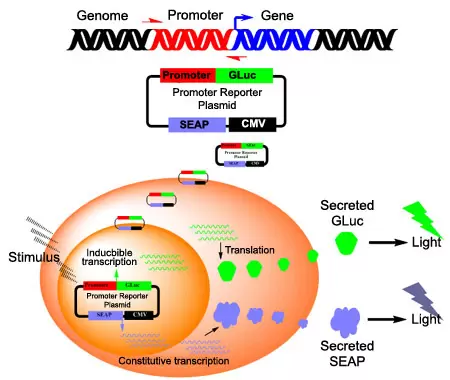Promoter Reporter Clones
GLuc-ON™ Promoter Reporter Clones
Using a secreted and robust Gaussia Luciferase (GLuc) as the reporter, GLuc-ON™ promoter clones are designed for promoter analysis by detecting the real-time activities of over 20,000 human and 18,000 mouse promoters using live cell assays.
- Each promoter clone contains a 1.2-1.5 kb insert corresponding to a gene-specific promoter
- Gaussia Luciferase (GLuc) as reporter gene ensures highly stable signal
- Dual-reporter vectors with GLuc as promoter reporter plus SEAP as internal control
- Single-reporter vectors with GLuc or a fluorescent protein as promoter reporter
Each transfection-ready promoter clone contains a 1.2-1.5 kb insert, corresponding to the 5'-flanking promoter sequence located approximately 1.5 kb upstream and up to 200 bp downstream of the transcription start site (TSS) of a specific gene. This insert is placed upstream of the GLuc reporter gene. Since the putative cis-acting enhancer elements are expected to exist in the cloned promoter region, the promoter luciferase activity observed during the reporter assay closely resembles the actual promoter regulation of these genes within human cells.
In addition to the dual-reporter system containing GLuc as the promoter reporter and Secreted Alkaline Phosphatase (SEAP) as the internal control for signal normalization, single-reporter vectors with GLuc or a fluorescent protein as the promoter reporter are available. GLuc-ON promoter reporter clones can be ordered as pre-designed or custom-built in one of our robust vector systems.
How GLuc-ON Promoter Clones Work

Assay Kits
Depending on the reporter vector, the Secrete-Pair Dual Luminescence Assay Kit (dual reporter GLuc and SEAP) or the Secrete-Pair Gaussia Luciferase Assay Kit (single reporter GLuc) are recommended for promoter analysis using GeneCopoeia's GLuc-ON™ Promoter Reporter Clones.
Gaussia Luciferase
GLuc-ON promoter clones use a modified GLuc (mGLuc) as the reporter gene, which generates a highly stable signal and overcomes the quick signal decay commonly observed with humanized wild type GLuc (wtGLuc).